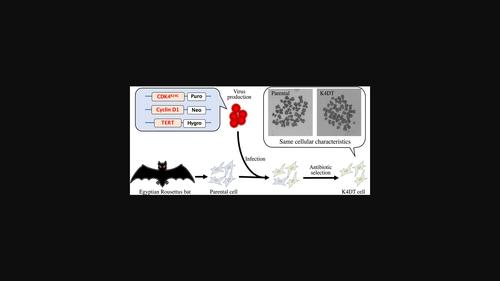当前位置:
X-MOL 学术
›
FEBS Open Bio
›
论文详情
Our official English website, www.x-mol.net, welcomes your feedback! (Note: you will need to create a separate account there.)
Establishment of immortalized Egyptian Rousettus bat cell lines
FEBS Open Bio ( IF 2.6 ) Pub Date : 2024-02-19 , DOI: 10.1002/2211-5463.13781 Lanlan Bai 1 , Tetsuya Tani 2 , Takeshi Kobayashi 3 , Ryotaro Nouda 3 , Yuta Kanai 3 , Yusuke Sano 4 , Kazutoshi Takami 5 , Hiroshi Tomita 1 , Eriko Sugano 1 , Taku Ozaki 1 , Tohru Kiyono 6 , Tomokazu Fukuda 1
FEBS Open Bio ( IF 2.6 ) Pub Date : 2024-02-19 , DOI: 10.1002/2211-5463.13781 Lanlan Bai 1 , Tetsuya Tani 2 , Takeshi Kobayashi 3 , Ryotaro Nouda 3 , Yuta Kanai 3 , Yusuke Sano 4 , Kazutoshi Takami 5 , Hiroshi Tomita 1 , Eriko Sugano 1 , Taku Ozaki 1 , Tohru Kiyono 6 , Tomokazu Fukuda 1
Affiliation

|
The Egyptian Rousettus bat (Rousettus aegyptiacus) is a common fruit bat species that is distributed mainly in Africa and the Middle East. Bats serve as reservoir hosts for numerous pathogens. Human activities, such as hunting bats for food, managing vermin, and causing habitat loss, elevate the likelihood of transmission of bat pathogens to humans and other animals. Consequently, bat cell lines play a crucial role as research materials for investigating viral pathogens. However, the inherent limitation of finite cell division in primary cells necessitates the use of immortalized cells derived from various bat tissues. Herein, we successfully established six fibroblast cell lines derived from an infant bat heart and lungs and an elderly bat heart. Three of the six cell lines, called K4DT cells, were transduced by a combination of cell cycle regulators, mutant cyclin-dependent kinase 4, cyclin D1, and human telomerase reverse transcriptase. The other three cell lines, named SV40 cells, were transfected with simian virus 40 large T antigen. Transgene protein expression was detected in the transduced cells. All three K4DT cell lines and one lung-derived SV40 cell line were virtually immortalized and nearly maintained the normal diploid karyotypes. However, the two other heart-derived SV40 cell lines had aberrant karyotypes and the young bat-derived cell line stopped proliferating at approximately 40 population doublings. These bat cell lines are valuable for studying pathogen genomics and biology.
中文翻译:

永生化埃及Rousettus蝙蝠细胞系的建立
埃及鲁塞图斯蝙蝠(Rousettus aegyptiacus)是一种常见的果蝠物种,主要分布在非洲和中东地区。蝙蝠是多种病原体的储存宿主。人类活动,例如猎杀蝙蝠获取食物、管理害虫以及导致栖息地丧失,增加了蝙蝠病原体传播给人类和其他动物的可能性。因此,蝙蝠细胞系作为研究病毒病原体的研究材料发挥着至关重要的作用。然而,原代细胞有限细胞分裂的固有限制使得必须使用源自各种蝙蝠组织的永生化细胞。在此,我们成功建立了来自婴儿蝙蝠心脏和肺以及老年蝙蝠心脏的六种成纤维细胞系。六种细胞系中的三种称为 K4DT 细胞,由细胞周期调节因子、突变细胞周期蛋白依赖性激酶 4、细胞周期蛋白 D1 和人端粒酶逆转录酶组合转导。另外三个细胞系,命名为SV40细胞,用猿猴病毒40大T抗原转染。在转导的细胞中检测到转基因蛋白表达。所有三种 K4DT 细胞系和一种肺源性 SV40 细胞系实际上都是永生化的,并且几乎保持了正常的二倍体核型。然而,另外两种源自心脏的 SV40 细胞系具有异常核型,而源自年轻蝙蝠的细胞系在大约 40 次群体倍增时停止增殖。这些蝙蝠细胞系对于研究病原体基因组学和生物学很有价值。
更新日期:2024-02-19
中文翻译:

永生化埃及Rousettus蝙蝠细胞系的建立
埃及鲁塞图斯蝙蝠(Rousettus aegyptiacus)是一种常见的果蝠物种,主要分布在非洲和中东地区。蝙蝠是多种病原体的储存宿主。人类活动,例如猎杀蝙蝠获取食物、管理害虫以及导致栖息地丧失,增加了蝙蝠病原体传播给人类和其他动物的可能性。因此,蝙蝠细胞系作为研究病毒病原体的研究材料发挥着至关重要的作用。然而,原代细胞有限细胞分裂的固有限制使得必须使用源自各种蝙蝠组织的永生化细胞。在此,我们成功建立了来自婴儿蝙蝠心脏和肺以及老年蝙蝠心脏的六种成纤维细胞系。六种细胞系中的三种称为 K4DT 细胞,由细胞周期调节因子、突变细胞周期蛋白依赖性激酶 4、细胞周期蛋白 D1 和人端粒酶逆转录酶组合转导。另外三个细胞系,命名为SV40细胞,用猿猴病毒40大T抗原转染。在转导的细胞中检测到转基因蛋白表达。所有三种 K4DT 细胞系和一种肺源性 SV40 细胞系实际上都是永生化的,并且几乎保持了正常的二倍体核型。然而,另外两种源自心脏的 SV40 细胞系具有异常核型,而源自年轻蝙蝠的细胞系在大约 40 次群体倍增时停止增殖。这些蝙蝠细胞系对于研究病原体基因组学和生物学很有价值。



























 京公网安备 11010802027423号
京公网安备 11010802027423号